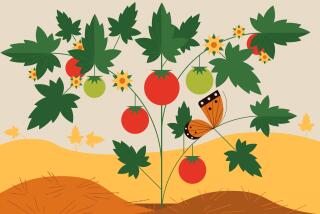Mistaking Insects for Fungis Can Harm Plant
Some county gardeners have been finding small blister-like growths on the leaves of their eugenia plants and treating them with fungicides. In fact, the culprit is a tiny insect pest called a psyllid that can quickly defoliate a plant.
“A lot of people will think it’s a fungus,” said Kris Nolte of Dana Point Nursery. The problem can be treated with a spraying of Orthene if caught quickly enough, but the situation often goes unnoticed at first because the eugenia--also known as the brush cherry--is usually “kind of a background plant,” Nolte said. Psyllid infestations have been on the rise in the past two years.
If caught too late, the only solution is to cut back the leaves and wait for new growth.
Tips from the California Nurserymen’s Assn.--Petunias can be deceiving. Beginning gardeners see young plants in bloom at the nursery when they are no larger than a teacup, not realizing that the plant can vastly increase in size.
Pinching new growth regularly will keep the plants compact. Petunias require sun. They should be planted 8 to 18 inches apart because they spread rapidly. The petunia provides good summer color, with shades including soft pink, deep red, light blue, purple, cream, yellow and white.
Fertilizers: Liquid or Dry?-- Many gardeners use liquid fertilizers, particularly varieties that are pre-mixed and attach to the hose, because of their convenience and fast action. The downside, however, is that they are usually washed away by the next watering.
Dry fertilizers, in contrast, combine slow- and fast-release foods. This allows some food to be used immediately while keeping some in store for future waterings. As always, follow the application and watering directions on the fertilizer package.
Thirsty Natives--California native plants are touted as one way to cut down on water use. While they are an excellent way to save water in the long run, gardeners should realize that in the first year they need about as much water as popular exotic plants.
This allows the plant to establish a viable root system and avoid shock in the crucial first year. After that, most native plants require little water and little maintenance.
Mulching Methods-- All lawns are not created equal, at least when it comes to mulching. Different grasses call for different approaches.
Bermudas and St. Augustine grasses are usually mulched in spring, after being mowed to ground level and fed. Dichondra lawns should be mulched when they start to reseed. These grasses all call for a deep mulch.
Blade grasses, on the other hand, should have a light mulch, a quarter to half an inch thick.
Summer is a good time to mulch a flower bed, as it keeps roots cooler and helps the soil retain water, as well as keeping weeds down. Mulching before a vacation is a good idea, as the garden or lawn will require less water.






